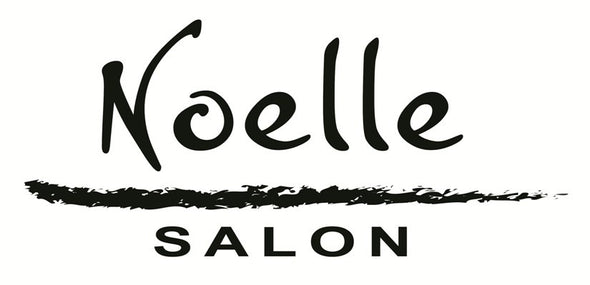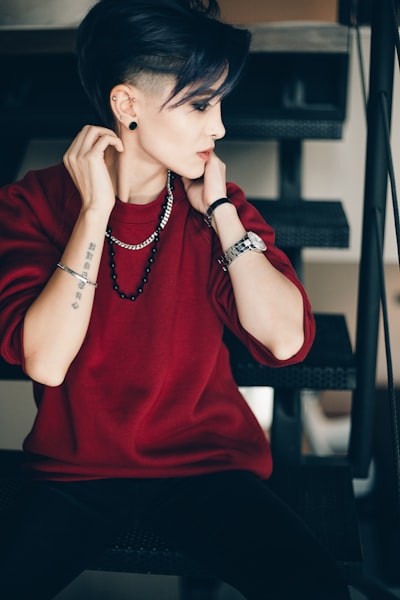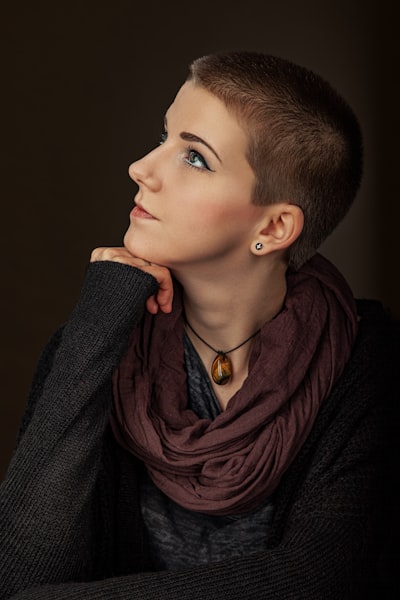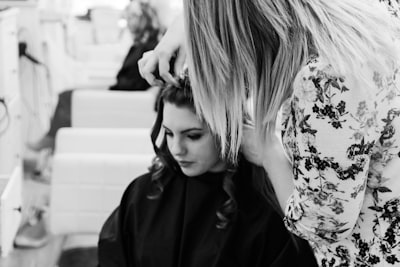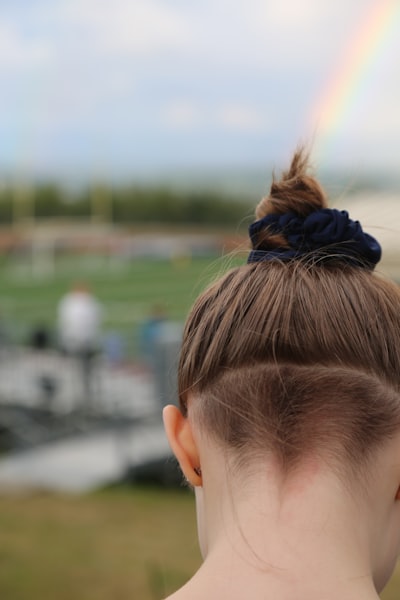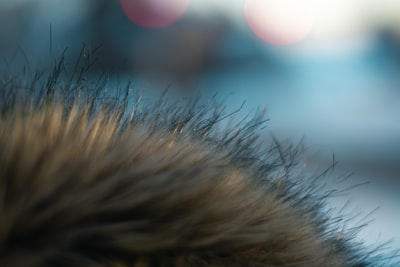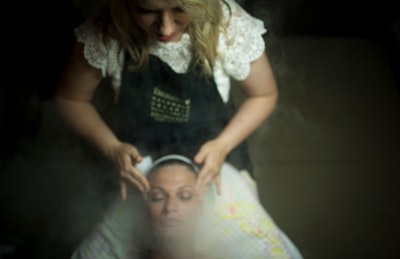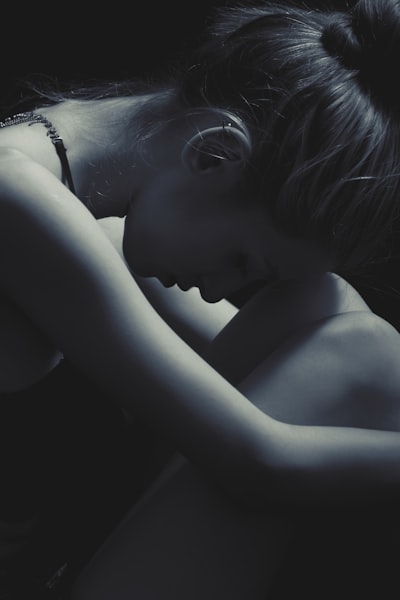The Ultimate Guide to Haircut for Trichotillomania

Mastering the Haircut for Trichotillomania: Ultimate Guide

Key Highlights
Trichotillomania, characterized by hair pulling, can cause hair loss and negatively impact mental health.
- Choosing the right haircut can help manage trichotillomania effectively by minimizing the visibility of bald spots and providing a sense of control.
Layered Bob, textured pixie cut, shoulder-length with bangs, short and tapered, long layers, buzz cut, and undercut are some of the best haircuts for managing trichotillomania.
- Styling tips such as using accessories to distract and cover, using products that minimize hair pulling, and techniques for reducing scalp visibility can also help manage trichotillomania-affected hair.
It is important to understand trichotillomania and its psychological aspects, the role of haircuts in management, and the importance of a supportive hair stylist.

Introduction
Trichotillomania, also known as hair-pulling disorder, is a mental health condition that involves recurrent, irresistible urges to pull out hair from the scalp, eyebrows, eyelids, and other areas of the body, including eyelashes. This compulsive behavior can lead to hair loss, bald spots, and significant distress. Managing trichotillomania can be challenging, but choosing the right haircut can make a significant difference in managing the condition effectively.
Hair pulling can be both a physical and emotional struggle for individuals with trichotillomania. It is often a coping mechanism for anxiety, stress, and boredom. The act of pulling hair can provide a sense of relief or satisfaction, but it can also lead to feelings of shame, guilt, and low self-esteem. Finding a haircut that not only covers the bald spots but also helps individuals feel confident and in control of their appearance, especially during high school years, can greatly improve their overall well-being.
In this blog, we will explore the top haircuts for managing trichotillomania and alopecia effectively. These haircuts are chosen based on their ability to minimize the visibility of bald spots caused by these conditions, create a sense of symmetry and balance, and provide options for styling that can distract from the urge to pull or cover up hair loss. We will also discuss styling tips, products, and techniques that can further aid in managing trichotillomania and alopecia-affected hair. By understanding the role of haircuts and adopting effective styling strategies, individuals with trichotillomania and alopecia can regain control over their hair and boost their self-confidence.
Best Haircut for Trichotillomania Effectively
Finding the right haircut is crucial for managing trichotillomania effectively. A skilled stylist can help create a haircut that not only covers the bald spots but also enhances the natural beauty of the individual. Here are some of the best haircuts for managing trichotillomania:
1. Layered Bob: A Versatile Choice
The layered bob is a versatile choice for managing trichotillomania. This haircut features layers of varying lengths, which can help create the illusion of volume and cover any bald spots or thinning areas. The layers add movement and texture to the hair, making it easier to style and maintain. A skilled hairstylist can customize the layered bob to suit the individual's face shape and hair type, ensuring a flattering and natural-looking result. Regular trims are essential to maintain the shape and promote healthy hair growth. With the right products and styling techniques, the layered bob can be a stylish and practical option for individuals with trichotillomania.
2. Textured Pixie Cut Short haircuts for Trichotillomania
The textured pixie cut is a trendy and low-maintenance haircut that can be a great option for managing trichotillomania. This haircut is characterized by short, textured layers that can add volume and movement to the hair. The short length minimizes the visibility of bald spots and makes it harder to grasp and pull the hair. Styling the textured pixie cut is easy and requires minimal effort. A quick tousle with some texturizing spray can create a stylish and effortless look. Regular visits to the salon for trims are necessary to maintain the shape and prevent excessive hair pulling. With its easy maintenance and chic appearance, the textured pixie cut can be a confidence-boosting choice for individuals with trichotillomania.
3. Shoulder-Length with Bangs: Cover and Style
Shoulder-length hair with bangs is a versatile and flattering option for managing trichotillomania. This haircut provides coverage for any bald spots or thinning areas while allowing room for different styling options. The bangs can be customized to suit the individual's face shape and personal style, providing a focal point that draws attention away from the hairline. A skilled hairdresser can create a shoulder-length haircut that enhances the natural texture and movement of the hair. Regular trims are necessary to maintain the shape and prevent split ends. With the right styling techniques and products, shoulder-length hair with bangs can be a stylish and practical choice for individuals with trichotillomania.
4. Short and Tapered: Easy to Handle
A short and tapered haircut can be an excellent choice for managing trichotillomania. This haircut features short sides and back with longer hair on top, creating a tapered effect. The short length minimizes the visibility of bald spots and makes it harder to pull the hair. The tapered style adds dimension and texture to the hair, making it easier to style and maintain with the use of a comb. A skilled barber can customize the short and tapered haircut to suit the individual's face shape and hair type. Regular trims are essential to maintain the shape and prevent excessive hair pulling. With its easy-to-handle nature and stylish appearance, the short and tapered haircut can be a practical and confidence-boosting option for individuals with trichotillomania.
5. Long Layers: For Those Who Prefer Length
For individuals who prefer longer hair, a haircut with long layers can be a suitable choice for managing trichotillomania. This haircut features layers that start below the chin and gradually blend into the length of the hair. The long layers add movement, volume, and dimension to the hair, making it harder to notice any bald spots or thinning areas. A skilled stylist can create long layers that complement the individual's face shape and hair type, ensuring a flattering and natural-looking result. Regular trims are necessary to maintain the shape and promote healthy hair growth. With the right care and styling techniques, long layers can be a versatile and manageable option for individuals with trichotillomania.
6. Buzz Cut: A Bold Move
For individuals who are ready to embrace a bolder look, a buzz cut can be a liberating choice for managing trichotillomania. This haircut involves shaving the hair very short, leaving a uniform length all over the scalp. The buzz cut eliminates the visibility of bald spots and makes it impossible to pull the hair with scissors. It provides a fresh start and allows the individual to focus on regrowth and healthy hair habits. However, it's important to consider the impact of a buzz cut on personal style and self-image. Some individuals may feel empowered and confident with a buzz cut, while others may prefer a hairstyle that offers more coverage. It's essential to consult with a trusted hairstylist or barber before making the decision to go for a buzz cut.
7. Undercut: Stylish Yet Functional
The undercut is a stylish and functional haircut option for managing trichotillomania. This haircut involves shaving or cutting the hair very short on the sides and back while leaving the top longer. The contrast between the short sides and the longer top creates a bold and edgy look. The undercut provides coverage for any bald spots or thinning areas while allowing for various styling options on the longer top. It can be customized to suit the individual's face shape and personal style. Regular visits to the salon are necessary to maintain the shape and prevent excessive hair pulling. With its versatility and contemporary appeal, the undercut, also known as a crew cut, can be a fashionable and practical choice for individuals with trichotillomania.
Styling Tips for Trichotillomania-Affected Hair
In addition to choosing the right haircut, there are several styling tips that can help manage trichotillomania-affected hair effectively. These tips involve using accessories like wigs, toppers, and hair fibers, such as Toppik, to distract and cover bald spots. Traditional hair extensions may not be the best option for trichotillomania clients, as they can cause discomfort and be easily pulled out. However, these alternatives can help camouflage any thinness. By incorporating these strategies into the daily hair care routine, individuals with trichotillomania can enhance their hair's appearance and minimize the urge to pull.
Using Accessories to Distract and Cover
Using accessories can be an effective way to distract from bald spots and cover them up. Here are some tips for using accessories to manage trichotillomania-affected hair:
- Headbands and scarves can be used to cover bald spots and add a stylish touch to the hairstyle.
- Hair clips and barrettes can be strategically placed to divert attention away from thinning areas.
- Hats and beanies are versatile accessories that can provide coverage and protection for the hair.
By incorporating these accessories into the hairstyle, individuals with trichotillomania can divert attention from bald spots and feel more confident about their hair.
Products That Minimize Hair Pulling
Using the right products can help minimize hair pulling and promote healthy hair growth. Here are some products that can be beneficial for individuals with trichotillomania-affected hair:
- Leave-in conditioners and detanglers can make the hair smoother and less prone to tangling, reducing the urge to pull.
- Scalp treatments containing nourishing ingredients such as argan oil or tea tree oil can improve scalp health and strengthen the hair follicles.
- Growth serums or supplements formulated to support hair growth can help stimulate the regrowth of hair in thinning areas.
By incorporating these products into their hair care routine, individuals with trichotillomania can nourish their hair and reduce the urge to pull.
Techniques for Reducing Scalp Visibility
Reducing scalp visibility can help manage trichotillomania-affected hair. Here are some techniques that can be useful:
- Backcombing or teasing the hair can create volume and cover up thinning areas.
Using dry shampoo or texturizing spray can add texture and grip to the hair, making it easier to style and conceal bald spots.
- Applying hair fibers or colored sprays specifically designed to camouflage hair loss can help create the illusion of thicker hair.
By employing these techniques, individuals with trichotillomania can minimize the visibility of their scalp and feel more confident about their hair.
The Psychological Aspect of Hair Pulling
Hair pulling in trichotillomania is not just a physical act but also has psychological implications. Individuals with trichotillomania may experience a range of emotions, including shame, guilt, and low self-esteem, due to their hair-pulling behavior. The act of pulling hair can provide temporary relief from anxiety or stress, but it can also exacerbate negative feelings and create a vicious cycle. Cognitive behavior therapy (CBT) can be beneficial in addressing the psychological aspect of hair pulling by helping individuals identify triggers, develop coping mechanisms, and modify their thoughts and behaviors. Seeking professional help from a mental health professional trained in CBT can provide valuable support and guidance in managing trichotillomania.
How Haircuts Can Aid in Management
Choosing the right haircut is an essential aspect of managing trichotillomania. Haircuts that provide coverage for bald spots, minimize the visibility of hair loss, and create a sense of control can significantly aid in managing the condition. A well-chosen haircut can help individuals feel more confident about their appearance, reduce the urge to pull, and provide a distraction from hair-pulling behaviors. Moreover, a supportive and understanding hairstylist or barber can play a vital role in the management of trichotillomania by providing guidance, empathy, and practical solutions. By working together with a trusted professional, individuals with trichotillomania can find the best haircut that suits their needs and supports their journey towards managing the condition effectively.
The Role of a Supportive Hair Stylist
A supportive hair stylist, also known as a trich specialist, can make a significant difference in the management of trichotillomania. It is essential to communicate openly and honestly with your hairstylist about your trichotillomania to ensure they understand your needs and concerns. A supportive hairstylist can provide guidance on suitable haircuts, styling techniques, and products that can help manage the condition effectively. They can also create a safe and non-judgmental environment where you feel comfortable discussing your hair-pulling behaviors and seeking advice. Building a trusting relationship with your hairstylist, or trich specialist, can be empowering and instrumental in managing trichotillomania.

Noelle Salon Blog
Haircuts play a crucial role in managing trichotillomania, offering both style and practicality. From layered bobs to buzz cuts, there are options to suit different preferences. Styling tips such as using accessories for distraction and selecting products that minimize hair pulling can aid in managing this condition effectively. Understanding trichotillomania's psychological aspect is key, along with having a supportive hair stylist. If you need personalized advice or further assistance, don't hesitate to get in touch with us. Together, we can find the best haircut solutions to help you navigate trichotillomania with confidence.

Frequently Asked Questions
How often should I change my haircut for trichotillomania effectively?
The frequency of changing your haircut to manage trichotillomania effectively can vary depending on individual preferences and hair growth. It is recommended to consult with a hairstylist who understands trichotillomania to determine the best timeline for haircuts based on your specific needs and hair growth rate.
Can certain hairstyles trigger more hair-pulling?
While certain hairstyles may make it easier to pull hair, the triggers for hair pulling can vary from person to person. It is essential to identify your own triggers and consult with a hairstylist who can recommend hairstyles that minimize the urge to pull and promote healthy hair habits.
What should I tell my hairstylist about my trichotillomania?
When discussing your trichotillomania with your hairstylist, it is important to communicate openly and honestly. You can explain your hair-pulling behaviors, concerns about bald spots or thinning areas, and any specific haircut preferences or styling needs. A supportive hairstylist will listen, provide guidance, and work with you to find the best solutions.
